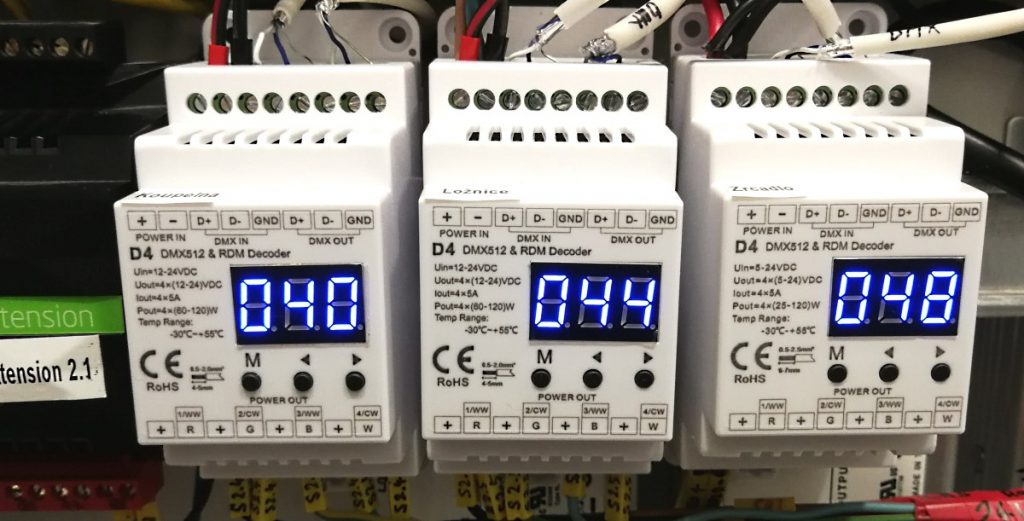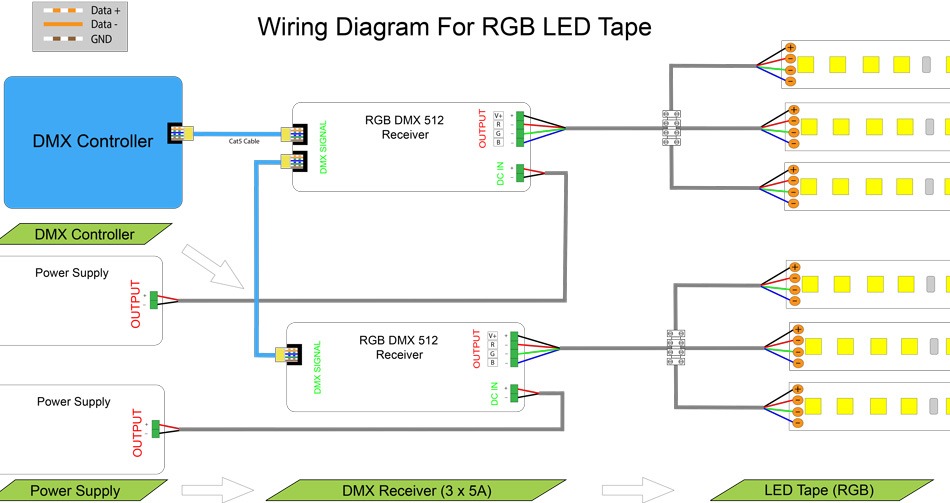Loxone, LED Strips and DMX
854 views
Skip to first unread message
Aiket Self Build
Apr 11, 2021, 1:03:36 PM4/11/21
to Loxone English
Evening, hope everyone is doing good... newbie to the group and to Loxone; We are embarking on a self build and will be using Loxone throughout so have lots of questions and its good to see some of our questions being answered in the group... The Loxone LED strips are cost prohibitive for us to use them so we are looking at what switching this to DMX looks like. We will have approx 21 RGBW strips splitting into 10ish "zones".
Has anyone done this and what bits of tech are needed from the DMX Extension > Controllers >Strips... We will be using someone who knows what they are doing for the install but I like to get my head round all of this stuff too! Anyone done similar / got a diagram or recommendations for Hardware? Also looking for alternatives to the RGBW pendants... Not after much! :)
Duncan
Apr 11, 2021, 3:07:55 PM4/11/21
to Loxone English
non-loxone led strip is a fairly common install


you need:
a loxone dmx extension or 'dmx/udp bridge' if you want to go 3rd party
24v led strip (less current than 12v)
constant voltage dmx drivers (4 channels for each separate rgbw zone you want to control) , see internet/ebay/amazon/aliexpress
these can be sources for din rail mounting if you are going central

a 4ch driver can drive more than 1 strip if they are in the same zone, assuming they have enough current capacity for your required length of strip
the higher the leds/m the smoother the light effect - i favour 96leds/m rather than 60 and behind an white opaque cover in a channel it looks like a fairly smooth light stream rather than a series of dots. the potential power draw will be higher, but they are all dimmable so you can choose to limit the max output if you want
dmx wiring is a bus so has to go from the controller then in series to each dmx driver - there are 3 cores and it can use xlr connectors (avoid, they are big), bare wires/screw terminals or rj45 network type cables - most people use cheap cat5/6/7 cable for wiring the dmx bus and you should use a 120ohm resistor as a terminator at the last device on the bus
if you dont want to put your drivers/PSUs centrally, and wiring in series is going to be difficult, you can use a dmx splitter/repeater to create a branched install, and use several buses in different parts of the house - the wiring is the same for rgb or rgbw, its just the drivers and wiring to tape are different for rgbw

drivers need a local 24v power supply - some people put all the drivers and PSUs centrally, some people distribute them closer to the strips, which is more appropriate when the run between your central point and the strip is long, as the currents are quite high even at 24v and the power cables need to be quite chunky to avoid too high losses
if you use local distributed PSUs/drivers, they need to be accessible (eg behind kitchen plinths) so you can service them, its more likely the PSU dies rather than anything else
DMD1062
Apr 12, 2021, 1:26:56 AM4/12/21
to Loxone English
Really helpful response Duncan, thanks. I'm in a similar situation doing a renovation and putting in DMX LED strips and DMX RGBW Spots so this helped me understand things a lot better.
DMD1062
Apr 12, 2021, 1:33:53 AM4/12/21
to Loxone English
Sounds I'm in exactly the same position as you, relative newbie, installing Loxone but using DMX lighting. I'm also on the lookout for recommendations on DMX RGBW spots as well so if you have any joy with this or have any recommendations I'd be keen to know. Thanks
On Sunday, 11 April 2021 at 18:03:36 UTC+1 aiketse...@gmail.com wrote:
Rob_in
Apr 12, 2021, 4:02:59 AM4/12/21
to Loxone English
Check out the other thread on individually addressable LEDs too. I would be thinking very hard about those if doing things from scratch now.
If you want to use a Loxone DMX extension with 24v DMX dimmers I can recommend EldoLED LINEARdrive modules. We mainly have them driving spots but I got some 24v strip from IT-Tronics in Germany which works perfectly.
HTH,
Robin
Message has been deleted
Message has been deleted
Deac99
Apr 18, 2021, 3:21:57 PM4/18/21
to Loxone English
Hi,
I'm struggling with deciding on how to layout my lighting DMX drivers and PSU's centrally located or distributed. As Duncan mentioned above, distributed makes more sense if the runs are long. I'd love to hear your opinions of "At what point would you choose to go with distributed?" 10, 20, 30 meters etc? I know it all depends on how many lights you have and how many amps you are drawing but in general, how do you tend to decide? You just don't like working with wires larger than X or do you tend to say, anything over Y feet or meters you just prefer to distribute?
Also, I have the same question related to the audioserver - as I add Stereo Extensions, at what point would you consider distributing the extensions vs running larger wire to the speakers?
Thanks for any insights on this subject.
Mark
Simon Still
Apr 19, 2021, 4:59:18 AM4/19/21
to Loxone English
Most of my lighting is constant current LED ceiling spots (so they have drivers) but, as you'd expect, theres also some LED strip and some 240v lighting. I didn't want the drivers for the spots in the ceiling space so I've got a 'hub' on each floor which has all the drivers, and relays for that floor. A lot less cable to run than taking everything to a single central location , easily accessible for maintenance/repairs. Since each location has 240V/DMX/a bunch of CAT7 cables with 240v (5A flex) to the light fittings it *should* be fairly future proof.
Node Zero is in the basement with the main Loxone board. Ground floor has a small cupboard in the kitchen wall which contains all the isolating switches for kitchen appliances as well. First and second floors have the nodes within the built-in wardrobes in one of the bedrooms next to the Underfloor manifolds. A wooden box on magnetic clips covers it all, keeps it safe and stops anything getting knocked.
The only things I've had fail (touch wood) are 240v GU10 bulbs and the single cheap Chinese 240v DMX dimmer I used. I'm pretty sure it was the dimmer killing the GU10's and when the second replacement dimmer failed I swapped it out for a simple DMX relay board (realised I didn't need dimming on those lights anyway).
Deac99
Apr 19, 2021, 9:23:02 PM4/19/21
to Loxone English
Thanks Simon,
That makes good sense, a central cabinet on each floor makes perfect sense. Im curious of your opinion, if I only had a single floor that is roughly 200 Sq. Meters (~2,200 Sq ft.) and the cabinet was in one corner, would you consider an additional sub cabinet somewhere close to the middle or just run the wires from the corner? (I know there is no right / wrong answer here, just trying to figure out what other people do).
Also great timing with your comment on the magnets for the wooden box. I made a wooden box that matches the paneling to cover up a UFH manifold and have been wondering how I was going to attach it to the wall. That is an elegant solution!
Simon Still
Apr 20, 2021, 7:39:15 AM4/20/21
to Loxone English
>>with 240v (5A flex) to the light fittings
To be clear, I used 240v rated cable but am only running low voltages over it to the fittings >>Also great timing with your comment on the magnets for the wooden box.
Ours are just cheap plastic things. I was trying to find a pic and these came up which look more solid. 3.5kg pull.
I just looked at one of our covers and it had 3 catches. The weight is taken on the floor so it's only stopping it tipping but you can see that they're more than up to the job.
No real opinion on yours but think about the cable runs - CAT cable is so cheap it's not really worth worrying about but power cables do stack up in terms of cost and with both you've just got the issue of bulk - you can end up needing a sizeable duct.
Aiket Self Build
Apr 20, 2021, 7:57:08 AM4/20/21
to Loxone English
Thanks All... after asking the original question, never got back into looking at this. Thanks all for the comments / suggestions and ideas. Plenty of things to consider and go away and research. Really helpful, appreciate it.
Reply all
Reply to author
Forward
0 new messages
